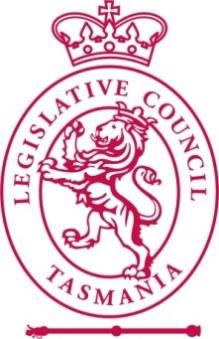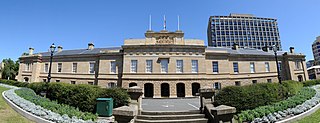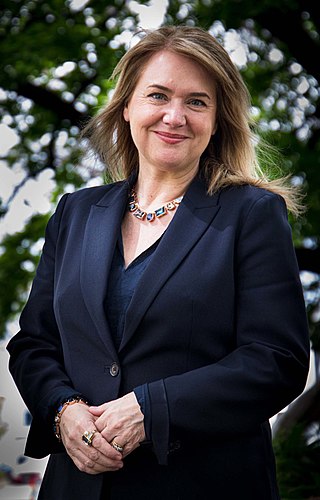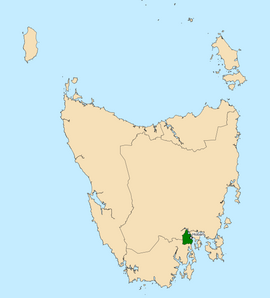
Andrew Inglis Clark was an Australian founding father and co-author of the Australian Constitution; he was also an engineer, barrister, politician, electoral reformer and jurist. He initially qualified as an engineer, but he re-trained as a barrister to effectively fight for social causes which deeply concerned him. After a long political career, mostly spent as Attorney-General and briefly as Opposition Leader, he was appointed a Senior Justice of the Supreme Court of Tasmania. Despite being acknowledged as the leading expert on the Australian Constitution, he was never appointed to the High Court of Australia.

The Tasmanian Greens are a political party in Australia which developed from numerous environmental campaigns in Tasmania, including the flooding of Lake Pedder and the Franklin Dam campaign. They form a part of the Australian Greens.

The House of Assembly, or Lower House, is one of the two chambers of the Parliament of Tasmania in Australia. The other is the Legislative Council or Upper House. It sits in Parliament House in the state capital, Hobart.

The Tasmanian Legislative Council is the upper house of the Parliament of Tasmania in Australia. It is one of the two chambers of the Parliament, the other being the House of Assembly. Both houses sit in Parliament House in the state capital, Hobart. Members of the Legislative Council are often referred to as MLCs.

The Parliament of Tasmania is the bicameral legislature of the Australian state of Tasmania. It follows a Westminster-derived parliamentary system and consists of the governor of Tasmania, the Legislative Council, and the House of Assembly. Since 1841, both Houses have met in Parliament House, Hobart. The Parliament of Tasmania first met in 1856.

The Division of Denison was an Australian electoral division in Tasmania, before being replaced by the Division of Clark as part of a 2016–17 redistribution.
The Division of Franklin is an Australian electoral division in Tasmania.

The electoral division of Franklin is one of the five electorates in the Tasmanian House of Assembly, located in southern Tasmania and includes Bruny Island, Kingston and the eastern shore of the Derwent River. Franklin is named after Sir John Franklin, the Arctic explorer who was Lieutenant-Governor of Van Diemen's Land (1837–43). The division shares its name and boundaries with the federal division of Franklin.

The electoral division of Bass is one of the five electorates in the Tasmanian House of Assembly, it includes north-east Tasmania and Flinders Island. Bass takes its name from the British naval surgeon and explorer of Australia: George Bass. The division shares its name and boundaries with the federal division of Bass.

The electoral division of Braddon is one of the five electorates in the Tasmanian House of Assembly, it includes north-west and western Tasmania as well as King Island. Braddon takes its name from the former Premier of Tasmania, Sir Edward Braddon. The division shares its name and boundaries with the federal division of Braddon.

The electoral division of Lyons is one of the five electorates in the Tasmanian House of Assembly, with the largest electorate and covering most of central and eastern Tasmania. Lyons is named jointly in honour of Joseph Lyons, Prime Minister of Australia (1932–1939); Premier of Tasmania (1923–1928), and Joseph's wife, Dame Enid Lyons, the first woman elected to the Australian House of Representatives in 1943. The electorate shares its name and boundaries with the federal division of Lyons.

The electoral division of Pembroke is one of the 15 electorates or 'seats' in the Tasmanian Legislative Council or upper house. It is located on Hobart's Eastern Shore and includes a number of suburbs; Risdon Vale, Geilston Bay, Rose Bay, Lindisfarne, Warrane, Mornington, Bellerive, Howrah and Tranmere. In earlier times, the division included most of the east coast of Tasmania as far north as Bicheno, including the Tasman Peninsula.

The electoral division of Derwent is one of the 15 electoral divisions in the Tasmanian Legislative Council. It is situated in the central south of the state.

The 1996 Tasmanian state election was held on 24 February 1996 in the Australian state of Tasmania to elect 35 members of the Tasmanian House of Assembly. The election used the Hare-Clark proportional representation system — seven members were elected from each of five electorates. The quota required for election was 12.5% in each division.

Parliament House, Hobart, located on Salamanca Place in Hobart, Tasmania, Australia, is the meeting place of the Parliament of Tasmania. The building was originally designed as a customs house but changed use in 1841 when Tasmania achieved self-government. The building served both purposes from 1841 to 1904, when the customs offices were relocated.
In Australia, a redistribution is the process of redrawing the boundaries of electoral divisions for the House of Representatives arising from changes in population and changes in the number of representatives. There is no redistribution for the Senate as each State constitutes a division, though with multiple members. The Australian Electoral Commission (AEC), an independent statutory authority, oversees the apportionment and redistribution process for federal divisions, taking into account a number of factors. Politicians, political parties and the public may make submissions to the AEC on proposed new boundaries, but any interference with their deliberations is considered a serious offence.

The 1909 Tasmanian state election was held on Friday, 30 April 1909 in the Australian state of Tasmania to elect 30 members of the Tasmanian House of Assembly. This was the first general election in the British Empire to elect all members through a form of proportional representation, the single transferable vote.

Cassandra Stanwell O'Connor is an Australian politician, who was a Tasmanian Greens member of the Tasmanian House of Assembly from 2008 to 2023, representing the electorate of Denison which was renamed to Clark in September 2018.

Madeleine Ruth Ogilvie is an Australian lawyer and politician. She is a Liberal Party member of the Tasmanian House of Assembly representing the Division of Clark and is a minister in the Second Rockliff ministry
The Division of Clark is an Australian Electoral Division in the state of Tasmania, first contested at the 2019 federal election.

















